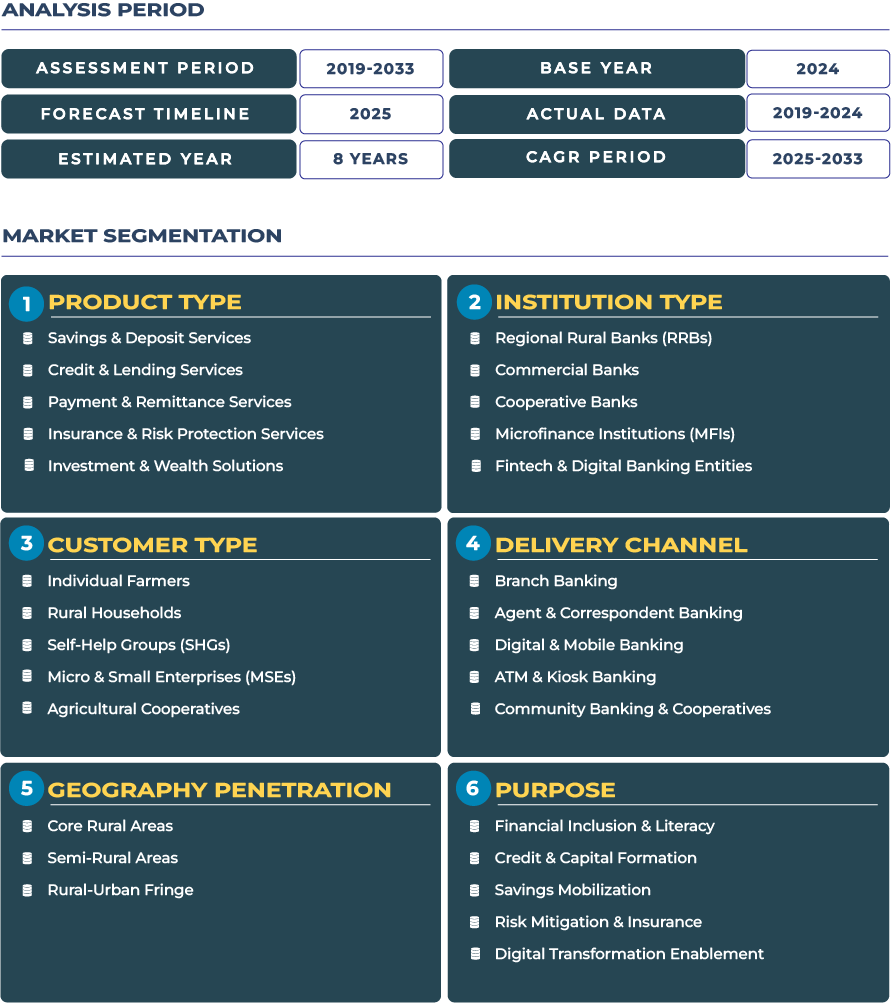Remittance-led Rural Economic Revival: Mexico Rural Banking Ecosystem Comes of Age
In Mexico rural banking market, remittance flows serve as the financial backbone that sustains rural households, stimulates micro-entrepreneurship and bridges the formal-informal finance divide. Rural families in states such as Michoacán, Oaxaca and Guerrero frequently depend on income sent from family members abroad, predominantly in the United States, which they channel into savings, agrarian investments and local commerce. These funds increasingly enter the formal banking system, providing a stepping stone for digital credit, savings products and insurance services tailored for rural regions. As such, the rural banking sector is evolving from an access challenge into a growth engine anchored by inclusion-driven innovation. By 2025, the Mexican rural banking market is projected at approximately USD 4.0 billion and is forecast to reach about USD 7.2 billion by 2033, implying a rob
Mexico Rural Banking Market Outlook: Growth Dynamics and Strategic Inflection Points in Mexico Rural Banking Sector
The Mexican rural banking landscape stands at a strategic inflection point, shaped by systemic reforms, fintech penetration and shifting demographic trends. The estimated Mexico rural banking market size growth by 2033 underscores rising demand for formal financial services in communities traditionally served by informal credit. Rural credit penetration remains historically low, fewer than ~8.5% of rural households accessed formal credit in earlier years, highlighting the latent growth potential. Institutions such as Secretaría de Hacienda y Crédito Público (SHCP) and the Comisión Nacional Bancaria y de Valores (CNBV) are advancing regulatory frameworks that support inclusive finance, digital lending and agent networks. Against the backdrop of rising geopolitical trade tensions and pandemic-driven supply-chain disruptions, rural agriculture has become more strategically important to national food-security initiatives. As banks and fintechs deepen their rural outreach, through remittance-collateralised micro-loans, mobile wallet integrations and branch-less banking, the rural banking ecosystem is shifting from under-penetration toward structural scale. The combination of government mandates, fintech agility and remittance-linked liquidity sets the stage for a new era of rural banking growth in Mexico.
Drivers & Restraints: Factors Shaping the Trajectory of Mexico Rural Banking Market
Key growth drivers: Major drivers include strong remittance inflows into rural households and nationwide rural electrification and digital-connectivity programmes. Remittances act not just as income supports but as financial collateral and deposit base for rural banks, enabling entry into credit and insurance services. The government’s commitment to rural infrastructure, roads, electricity and connectivity, enhances access and lowers cost-to-serve for lenders. Institutional platforms such as Financiera Nacional de Desarrollo Agropecuario, Rural, Forestal y Pesquero (FND) play a crucial role in expanding small-holder financing networks and formalising informal rural value chains. Together, these factors create a favourable environment for formal savings mobilisation, digital lending and risk-protection services in Mexico rural banking industry.
Constraining factors: On the other hand, structural impediments continue to hamper growth in the rural banking sector. The prevalence of informal land titles limits banks’ ability to accept collateral, thus constraining credit access and increasing risk weighting for lenders. Regional instability and cartel-driven violence raise credit-loss risk and increase security costs for rural banking operations. Branch-presence in rural municipalities remains low, formal bank branches cover only ~42.7% of rural localities versus 99.5% of urban ones, highlighting geographic and access gaps. Digital infrastructure, while improving, still lags in remote communities, making mobile-first approaches challenging for some segments. These constraints explain why, despite strong growth projections, the sector must overcome operational, legal and infrastructural barriers to fully realise its potential.
Trends & Opportunities: Innovation Frontiers in Mexico Rural Banking Segment
Emerging trends: Agent-banking models and biometric KYC acceptance at village-level points of service are gaining traction across rural Mexico. Financial institutions are leveraging remittance pipelines to offer remittance-collateralised credit and linking digital wallets to rural savings and payments. The growth of mobile money and embedded finance platforms fosters broader transaction and deposit flows into the rural banking ecosystem. Moreover, fintechs are increasingly layering risk-protection services, such as micro-insurance for crop failure and livestock risk, into rural credit packages.
Opportunity arenas: Considerable opportunity exists in remittance-backed micro-loans, offering smallholders flexible working-capital linked to off-farm income flows and migration remittances. Financing for small-scale avocado, berry and coffee exporters is another high-potential niche, rural banks can provide tailored credit and investment/wealth solutions linked to export-value chains. Community-shared leasing schemes for cold-chain infrastructure and digital-enabled savings platforms for seasonal workers are additional growth corridors. For banks and fintechs positioned in Mexico rural banking industry, the combination of remittance linkages, digital platforms and inclusive product design presents a unique competitive advantage.
Competitive Landscape: Strategic Partnerships and Digital Innovation Driving Rural Banking in Mexico
Key players in Mexico rural banking market are adopting strategies that align credit access with digital inclusion and network reach. In October 2025, Revolut received final authorisation from Mexico’s CNBV to operate as a full banking institution, signalling heightened fintech participation in rural financial services. In February 2025, Walmex (Walmart Mexico & Central America unit) launched a digital account service “Cashi” to support remittance receipt and credit services for rural clients. These developments reflect strategic shifts: banks and fintechs are offering remittance-collateralised credit, deploying agent-networks with biometric KYC to serve sparsely populated regions and embedding value-chain finance alongside deposit and insurance services. Mexican rural banking institutions increasingly pursue partnerships with payment platforms, agribusiness suppliers and local co-ops to reduce credit risk, lower acquisition costs and expand outreach in underserved rural markets. As the rural banking ecosystem evolves, players combining technology, credit and inclusion stand to lead the market transformation.








